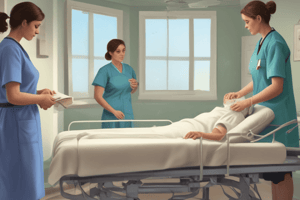Podcast
Questions and Answers
Which finding post-surgery should be immediately reported to the healthcare provider?
Which finding post-surgery should be immediately reported to the healthcare provider?
- Redness and warmth at the surgical site. (correct)
- Serous drainage from the surgical site.
- Occasional phantom limb pain.
- Mild edema at the surgical site.
A client is experiencing phantom limb pain post-amputation. Which non-pharmacological intervention might be helpful?
A client is experiencing phantom limb pain post-amputation. Which non-pharmacological intervention might be helpful?
- Massaging the residual limb vigorously.
- Encouraging the client to focus intently on the pain.
- Using distraction techniques, such as listening to music. (correct)
- Applying ice to the residual limb.
When teaching a client about using a compression bandage on the residual limb after amputation, which instruction is correct?
When teaching a client about using a compression bandage on the residual limb after amputation, which instruction is correct?
- Apply the bandage loosely to promote circulation.
- Apply the bandage from distal to proximal. (correct)
- Rewrap the bandage only once a day.
- Use non-elastic bandages.
A client who had an amputation is concerned about changes in body image. Which nursing intervention is most helpful?
A client who had an amputation is concerned about changes in body image. Which nursing intervention is most helpful?
A nurse is helping a client with crutch walking post-amputation. What action indicates proper technique?
A nurse is helping a client with crutch walking post-amputation. What action indicates proper technique?
Vigorous massaging of the residual limb is a recommended method for managing phantom limb pain.
Vigorous massaging of the residual limb is a recommended method for managing phantom limb pain.
Applying a compression bandage too ______ can impair circulation in the residual limb.
Applying a compression bandage too ______ can impair circulation in the residual limb.
Besides providing information about prosthetics, what is another nursing intervention to improve body image after an amputation?
Besides providing information about prosthetics, what is another nursing intervention to improve body image after an amputation?
What is the priority nursing action when a patient is admitted to the post-operative unit after an above-the-knee amputation?
What is the priority nursing action when a patient is admitted to the post-operative unit after an above-the-knee amputation?
Applying lotions and powders to the stump is recommended to keep the skin moisturized.
Applying lotions and powders to the stump is recommended to keep the skin moisturized.
A nurse is caring for a patient who reports phantom limb pain after an amputation. Besides pharmacological interventions, what non-pharmacological pain management technique can the nurse explore with the patient?
A nurse is caring for a patient who reports phantom limb pain after an amputation. Besides pharmacological interventions, what non-pharmacological pain management technique can the nurse explore with the patient?
To prevent hip or knee flexion contracture after an amputation, the patient should be encouraged to lie ______ for 30 minutes three or four times a day.
To prevent hip or knee flexion contracture after an amputation, the patient should be encouraged to lie ______ for 30 minutes three or four times a day.
Match the following nursing interventions with their corresponding rationale in postoperative amputation care:
Match the following nursing interventions with their corresponding rationale in postoperative amputation care:
A nurse is educating a client who is being discharged home after a below-the-knee amputation. Which statement by the client indicates a need for further teaching?
A nurse is educating a client who is being discharged home after a below-the-knee amputation. Which statement by the client indicates a need for further teaching?
It is appropriate to clean the residual limb with alcohol to prevent infection.
It is appropriate to clean the residual limb with alcohol to prevent infection.
What type of sock should a patient be encouraged to use to help mold the stump into a conical shape?
What type of sock should a patient be encouraged to use to help mold the stump into a conical shape?
In the immediate postoperative period, the residual limb should be elevated for the first ______ hours to minimize swelling, as prescribed.
In the immediate postoperative period, the residual limb should be elevated for the first ______ hours to minimize swelling, as prescribed.
Which of the following interventions is most important for preventing contractures in a client following a lower extremity amputation?
Which of the following interventions is most important for preventing contractures in a client following a lower extremity amputation?
Massaging the residual limb is the most appropriate initial intervention for phantom limb pain.
Massaging the residual limb is the most appropriate initial intervention for phantom limb pain.
What should be documented regarding the surgical site?
What should be documented regarding the surgical site?
Discourage the patient from placing a ______ under the stump.
Discourage the patient from placing a ______ under the stump.
A nurse is providing psychological support . Which approach is most helpful?
A nurse is providing psychological support . Which approach is most helpful?
It is recommended to keep the residual limb elevated at all times to promote comfort and reduce edema.
It is recommended to keep the residual limb elevated at all times to promote comfort and reduce edema.
Flashcards
Redness and Warmth at Surgical Site
Redness and Warmth at Surgical Site
A sign of potential infection requiring immediate attention.
Distraction for Phantom Limb Pain
Distraction for Phantom Limb Pain
Techniques like music can shift the patient's focus away from the pain.
Distal to Proximal Bandage
Distal to Proximal Bandage
Applying the bandage in this direction aids in shaping and reducing swelling.
Prosthetic Device Information
Prosthetic Device Information
Signup and view all the flashcards
Crutches and Affected Leg Together
Crutches and Affected Leg Together
Signup and view all the flashcards
Edema
Edema
Signup and view all the flashcards
Serous Drainage
Serous Drainage
Signup and view all the flashcards
Phantom Limb Pain
Phantom Limb Pain
Signup and view all the flashcards
Pre-Op Amputation Care
Pre-Op Amputation Care
Signup and view all the flashcards
Post-Op Monitoring
Post-Op Monitoring
Signup and view all the flashcards
Compression Dressings
Compression Dressings
Signup and view all the flashcards
Limb Elevation
Limb Elevation
Signup and view all the flashcards
Psychological Support
Psychological Support
Signup and view all the flashcards
Stump Care
Stump Care
Signup and view all the flashcards
Prolonged Sitting Post-Amputation
Prolonged Sitting Post-Amputation
Signup and view all the flashcards
Pillow Under Stump
Pillow Under Stump
Signup and view all the flashcards
Elevating Residual Limb Post-Op
Elevating Residual Limb Post-Op
Signup and view all the flashcards
Treating Phantom Limb Pain
Treating Phantom Limb Pain
Signup and view all the flashcards
Residual Limb Inspection
Residual Limb Inspection
Signup and view all the flashcards
Preventing Contractures
Preventing Contractures
Signup and view all the flashcards
Phantom Limb Sensation
Phantom Limb Sensation
Signup and view all the flashcards
Shrinker Sock
Shrinker Sock
Signup and view all the flashcards
Study Notes
Preoperative Care
- Assess a patient's physical and psychological well-being prior to amputation surgery.
- Determine the patient's understanding of the surgery, rehab, and lifestyle changes.
- Record patient baselines using vital signs and lab values.
- The surgical site must be marked before the procedure begins.
- Administer antibiotics as directed, to prevent infection.
- Elevating the limb, when ordered, supports good circulation.
- Provide emotional support and address patient fears.
- Work with the surgeon, prosthetist, and physical therapist for best results.
Postoperative Care
- Monitor vital signs and pain levels on a regular schedule.
- Check the surgical site for bleeding, edema, redness, drainage, and odor.
- Apply compression dressings to the residual limb to minimize swelling and shape the limb.
- Elevate the residual limb for 24-48 hours, or as ordered, to minimize swelling.
- Watch for signs and symptoms of infection, including fever, increased pain, and purulent drainage.
- Give pain medications as prescribed, and explore non-drug pain relief methods.
- Assess the patient's emotional state and coping mechanisms.
- Encourage the patient rehabilitation.
- Encourage active range-of-motion exercises to prevent contractures and promote mobility.
- Work with physical and occupational therapists to create a plan of care for patient.
- Provide patient education about residual limb care, including washing and drying every day.
- Educate the patient on using assistive devices, like crutches and walkers.
- Educate the patient about phantom limb pain and phantom sensation.
Psychological Support
- Encourage the patient to share any feelings and concerns related to the amputation.
- Be supportive and non-judgemental.
- Provide access to counseling or support groups.
- Promote a positive self-image.
- Assist the patient in making achievable rehab goals.
- Encourage participation in activities and hobbies to promote normalcy.
- Help the patient deal with grief, loss, or body image concerns.
- Educate the patient and family on coping strategies and resources.
Stump Care
- Look for skin breakdown, especially over pressure points.
- Cleanse the stump daily with mild soap and water.
- Lotions, powders, and alcohol should be avoided to prevent dry skin and irritation.
- Change the stump sock every day, and wash with mild detergent.
- Use a shrinker sock to mold the stump into a conical shape.
- Prevent edema by not allowing the stump to hang over the bed.
- Teach the patient how to wrap the stump to promote healing and shaping.
Positioning
- Prevent hip or knee flexion contractures.
- Teach patients not to sit for long periods.
- A pillow should not be placed under the stump.
- Lie prone 3-4 times daily for 30 minutes.
NCLEX-Style Questions
-
After an above-the-knee amputation, elevating the residual limb is most important in the immediate postoperative period, as it reduces edema and promotes venous return
-
Correct answer: B
-
Phantom limb pain is common after amputation, administer pain medication as prescribed.
-
Correct answer: A
-
Teach the patient to inspect the residual limb daily for signs of skin breakdown.
-
Correct answer: C
-
Understanding of discharge instructions is demonstrated when the patient states they will, "inspect my residual limb for signs of infection."
-
Correct answer: C
-
Active range-of-motion exercises are most important for preventing contractures.
-
Correct answer: C
-
Report redness and warmth at the surgical site immediately, as these are signs of possible infection.
-
Correct answer: C
-
Using distraction techniques, like listening to music, can help with phantom limb pain.
-
Correct answer: D
-
When using a compression bandage, apply from distal to proximal to help shape the residual limb and reduce edema.
-
Correct answer: D
-
Provide information about prosthetic devices to improve body image concerns.
-
Correct answer: B
-
Proper crutch walking technique involves moving both crutches and the affected leg forward simultaneously to promote stability and balance.
-
Correct answer: D
Studying That Suits You
Use AI to generate personalized quizzes and flashcards to suit your learning preferences.




